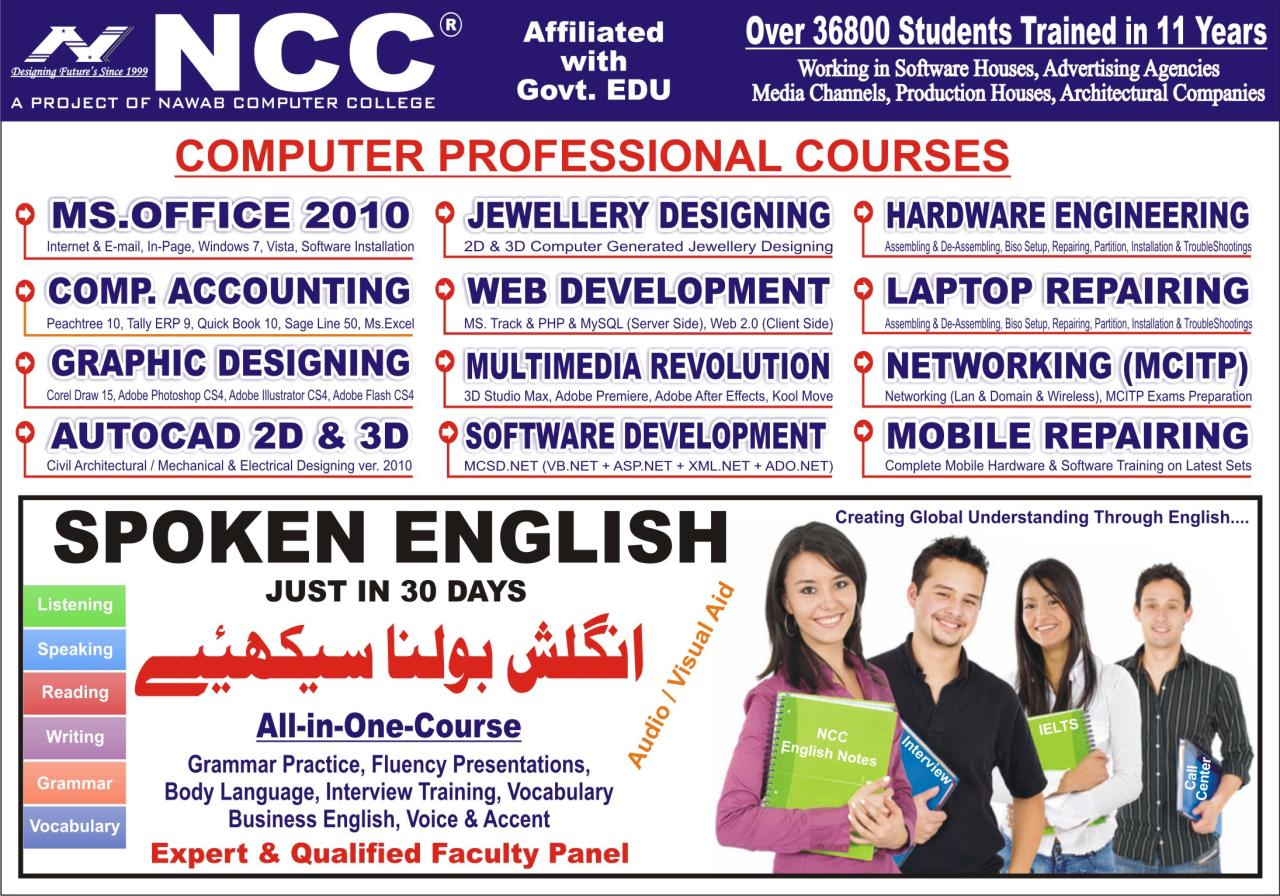IT Courses offer a gateway to exciting careers in technology. Whether you’re a complete beginner or looking to upskill, the right IT course can transform your prospects. From cybersecurity to data analytics, the field is vast and constantly evolving, presenting numerous opportunities for growth and high earning potential. This guide explores the diverse world of IT courses, helping you navigate the options and choose the path that best suits your aspirations.
We’ll cover everything from understanding different course types and curricula to choosing the right provider and mastering effective study techniques. We’ll also examine the future of IT education and how it’s adapting to the ever-changing demands of the tech industry. Get ready to embark on your tech journey!
Types of IT Courses

The IT field offers a vast array of courses catering to diverse interests and career goals. Understanding the different types of courses available is crucial for making informed decisions about your education and future career path. This section categorizes common IT courses, compares certifications and degrees, and contrasts online and in-person learning.
Categorized List of Common IT Courses
The following table provides a categorized list of common IT courses, outlining their descriptions and typical durations. These are estimates, and actual durations can vary depending on the institution and course intensity.
| Course Category | Course Name | Description | Typical Duration |
|---|---|---|---|
| Networking | CCNA (Cisco Certified Network Associate) | Covers fundamental networking concepts, including routing, switching, and network security. | 6-12 months |
| Cybersecurity | CompTIA Security+ | Focuses on core security concepts and best practices. | 3-6 months |
| Data Analytics | Data Analysis with Python | Teaches data manipulation, analysis, and visualization using Python. | 4-8 weeks |
| Cloud Computing | AWS Certified Cloud Practitioner | Introduces core cloud concepts and services on the Amazon Web Services (AWS) platform. | 4-8 weeks |
| Software Development | Introduction to Java Programming | Provides foundational knowledge of Java programming language and object-oriented programming. | 12-16 weeks |
Certifications vs. Degree Programs in IT
IT certifications and degree programs offer distinct pathways to a career in technology. Certifications focus on specific skills and technologies, while degree programs provide a broader, more theoretical foundation.
| Feature | Certification | Degree Program |
|---|---|---|
| Focus | Specific skills and technologies | Broader theoretical and practical knowledge |
| Duration | Typically shorter, weeks to months | Typically longer, years |
| Cost | Generally less expensive | Generally more expensive |
| Recognition | Employer-specific or industry-wide recognition | Widely recognized by employers |
Online vs. In-Person IT Courses
Choosing between online and in-person IT courses depends on individual learning styles, preferences, and circumstances. Both options have advantages and disadvantages.
| Feature | Online Courses | In-Person Courses |
|---|---|---|
| Flexibility | High flexibility in scheduling and location | Less flexible, requires attending scheduled classes |
| Cost | Potentially lower cost, but may require additional expenses for equipment | Potentially higher cost, but may include resources and equipment |
| Interaction | Limited face-to-face interaction with instructors and peers | More opportunities for face-to-face interaction |
| Self-Discipline | Requires high level of self-discipline and time management | Less reliance on self-discipline |
IT Course Curriculum Content
The curriculum of an IT course varies widely depending on the specialization. However, foundational courses typically cover core concepts applicable across various IT fields. Specializations then delve deeper into specific areas.
Typical Modules in a Foundational IT Course
A basic IT course often includes these modules to build a solid foundation.
- Computer Hardware and Software Fundamentals
- Operating Systems (Windows, macOS, Linux)
- Networking Basics (TCP/IP, LAN, WAN)
- Introduction to Databases
- Basic Troubleshooting and Problem-Solving
- Introduction to Programming Concepts
Sample Cybersecurity Specialization Curriculum
A cybersecurity specialization builds upon foundational knowledge with more advanced topics.
- Network Security
- Ethical Hacking and Penetration Testing
- Security Auditing and Compliance
- Incident Response and Forensics
- Cloud Security
- Cryptography
Key Skills Acquired in a Data Analytics IT Course
Data analytics courses equip students with essential skills for extracting insights from data.
| Skill | Description |
|---|---|
| Data Cleaning and Preprocessing | Handling missing values, outliers, and inconsistencies in datasets. |
| Statistical Analysis | Applying statistical methods to analyze and interpret data. |
| Data Visualization | Creating charts and graphs to communicate data insights effectively. |
| Data Mining and Machine Learning | Using algorithms to discover patterns and make predictions from data. |
| Programming (Python, R, SQL) | Using programming languages for data manipulation and analysis. |
Career Paths After IT Courses
Completing various IT courses opens doors to a range of exciting career paths. The specific path depends on the chosen specialization and acquired skills. Career progression is often a journey of continuous learning and skill development.
Five Different Career Paths
Here are five common career paths accessible after completing different IT courses.
- Network Administrator
- Cybersecurity Analyst
- Data Analyst
- Cloud Engineer
- Software Developer
Potential Career Progression in IT
The following flowchart illustrates a simplified example of potential career progression. Actual paths can be more complex and varied.
(Imagine a flowchart here showing a starting point “IT Fundamentals Course,” branching into “Networking,” “Cybersecurity,” “Data Analytics,” etc., with further branches representing potential career advancements within each specialization. For example, from “Networking” it could branch to “Network Engineer,” “Network Architect,” etc.)
Thinking about boosting your career with some IT courses? Learning new skills can open doors, just like the Orioles are doing by signing veteran pitcher Charlie Morton; check out the details here: O’s agree to 1-year deal with veteran SP Charlie Morton. Similarly, investing in IT training is a smart move for long-term career growth. So, browse those course catalogs!
Salary Expectations and Job Market Demand

Salary expectations and job market demand vary significantly across different IT specializations. Generally, roles requiring specialized skills and experience command higher salaries and are in higher demand. For example, cybersecurity professionals are currently in high demand due to the increasing prevalence of cyber threats. Data scientists and cloud engineers also experience strong demand due to the growing reliance on data-driven decision-making and cloud-based services.
Specific salary figures vary based on location, experience, and employer.
Choosing the Right IT Course
Selecting the right IT course requires careful consideration of various factors. A well-informed decision ensures your education aligns with your career goals and learning style.
Thinking about boosting your career with IT courses? It’s a smart move, offering diverse opportunities. The news about the tragic events in New Orleans, where a British victim, as reported here British victim of New Orleans attack is stepson of William and Harry’s , is sadly a reminder of the importance of staying informed. Regardless, investing in IT skills equips you for future challenges and opens doors to exciting possibilities.
Factors to Consider When Selecting an IT Course
Individuals should consider these factors before enrolling in an IT course.
- Career Goals: What specific IT role are you aiming for?
- Learning Style: Do you prefer self-paced online learning or structured classroom instruction?
- Budget: What is your budget for tuition fees and other expenses?
- Course Content: Does the curriculum align with your interests and career goals?
- Instructor Expertise: Is the instructor experienced and knowledgeable in the field?
- Accreditation: Is the course accredited by a reputable organization?
Step-by-Step Guide for Researching and Evaluating Course Providers, It courses
A systematic approach helps in choosing a suitable IT course provider.
- Identify your career goals and desired specialization.
- Research different IT course providers online (e.g., websites, reviews).
- Compare course curricula, duration, cost, and instructor qualifications.
- Check for student reviews and testimonials.
- Contact the providers to ask questions and clarify any doubts.
- Consider attending an online or in-person information session.
Assessing the Credibility and Reputation of an IT Training Institution
Several factors indicate the credibility of an IT training institution.
- Accreditation by reputable organizations (e.g., industry bodies).
- Positive student reviews and testimonials.
- Experienced and qualified instructors.
- Up-to-date curriculum reflecting industry trends.
- Strong job placement assistance.
Learning Resources for IT Courses
Effective learning strategies and supplementary resources enhance the learning experience and knowledge retention. Utilizing a variety of resources caters to different learning styles and preferences.
Effective Study Techniques for Mastering IT Course Material
These techniques can help students master IT course material.
- Active Recall: Test yourself regularly on the material.
- Spaced Repetition: Review material at increasing intervals.
- Practice Coding/Hands-on Projects: Apply your knowledge through practical exercises.
- Form Study Groups: Collaborate with peers and discuss concepts.
- Seek Clarification: Don’t hesitate to ask instructors or peers for help.
Reputable Online Resources for Learning IT Skills
These platforms offer valuable resources for supplementing formal IT courses.
- Coursera
- edX
- Udemy
- Khan Academy
- YouTube (educational channels)
Benefits and Drawbacks of Different Learning Methods
Different learning methods offer unique advantages and disadvantages.
- Video Tutorials: Benefits – Visual learning, easy to follow. Drawbacks – Passive learning, may lack interactivity.
- Interactive Simulations: Benefits – Engaging, hands-on experience. Drawbacks – May not fully replicate real-world scenarios.
- Hands-on Projects: Benefits – Practical application of knowledge, problem-solving skills. Drawbacks – Requires more time and effort.
The Future of IT Courses
The IT industry is constantly evolving, and IT education must adapt to meet the changing demands. Emerging technologies and industry trends significantly influence the future of IT courses.
Emerging Trends Shaping the Future of IT Education

Several trends are shaping the future of IT education.
So you’re looking at IT courses? That’s awesome! If you’re aiming for a career as a full-stack developer, check out this resource on affordable full stack developer bootcamps with job placement to fast-track your skills. Many bootcamps offer intensive training that complements traditional IT courses, giving you a head start in the job market.
It’s a great way to boost your IT course learning and land a job quickly.
- Increased focus on practical skills and hands-on experience.
- Integration of emerging technologies (e.g., AI, machine learning, blockchain).
- Personalized learning experiences tailored to individual needs.
- Greater emphasis on soft skills (e.g., communication, teamwork, problem-solving).
- Use of immersive technologies (e.g., virtual and augmented reality).
Impact of Artificial Intelligence on IT Course Design and Delivery
AI is transforming IT education in several ways.
- Personalized learning pathways based on student progress and learning styles.
- AI-powered tutoring systems providing individualized support.
- Automated assessment and feedback mechanisms.
- Development of new AI-related courses and specializations.
Adaptation of IT Courses to Evolving Tech Industry Needs
IT courses are adapting to meet the evolving needs of the tech industry by:
- Incorporating new technologies and frameworks into curricula.
- Offering specialized courses in emerging areas (e.g., data science, cybersecurity).
- Developing partnerships with industry leaders to provide relevant training.
- Focusing on developing problem-solving and critical thinking skills.
Ending Remarks

Ultimately, the success of your IT training hinges on careful planning and dedicated effort. By understanding the various course options, identifying your career goals, and utilizing effective learning strategies, you can build a strong foundation for a thriving career in technology. The world of IT is dynamic and rewarding; with the right preparation and commitment, you can unlock incredible opportunities and shape the future of technology.
FAQ Corner
What’s the difference between a bootcamp and a degree program?
Bootcamps are intensive, short-term programs focusing on practical skills, while degree programs offer broader theoretical knowledge and often lead to higher qualifications.
How much does an IT course typically cost?
Costs vary greatly depending on the course type, duration, and provider. Expect to pay anywhere from a few hundred to several thousand dollars.
Are online IT courses as effective as in-person ones?
Effectiveness depends on individual learning styles and self-discipline. Online courses offer flexibility, while in-person courses provide more direct interaction with instructors and peers.
What if I don’t have any prior IT experience?
Many introductory IT courses are designed for beginners. Start with foundational courses before moving onto specialized areas.
